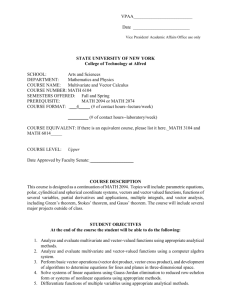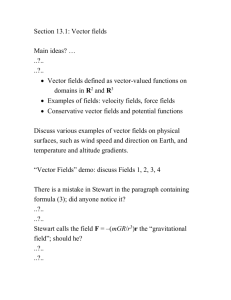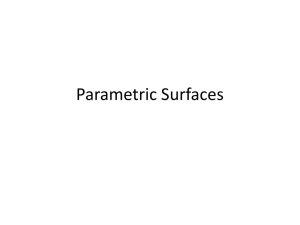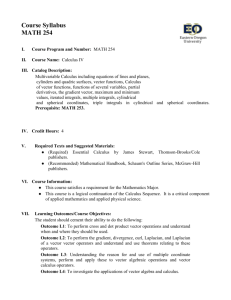Section 11.1: Vector
advertisement
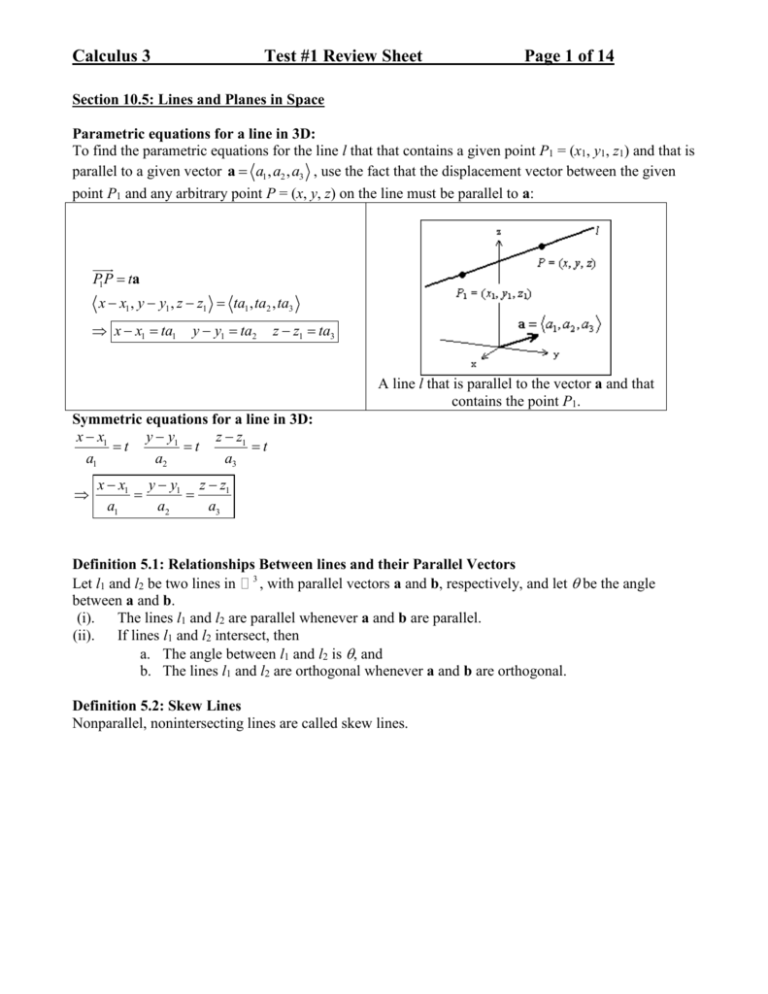
Calculus 3 Test #1 Review Sheet Page 1 of 14 Section 10.5: Lines and Planes in Space Parametric equations for a line in 3D: To find the parametric equations for the line l that that contains a given point P1 = (x1, y1, z1) and that is parallel to a given vector a a1 , a2 , a3 , use the fact that the displacement vector between the given point P1 and any arbitrary point P = (x, y, z) on the line must be parallel to a: PP ta 1 x x1 , y y1 , z z1 ta1 , ta2 , ta3 x x1 ta1 y y1 ta2 z z1 ta3 A line l that is parallel to the vector a and that contains the point P1. Symmetric equations for a line in 3D: x x1 y y1 z z1 t t t a1 a2 a3 x x1 y y1 z z1 a1 a2 a3 Definition 5.1: Relationships Between lines and their Parallel Vectors Let l1 and l2 be two lines in 3 , with parallel vectors a and b, respectively, and let be the angle between a and b. (i). The lines l1 and l2 are parallel whenever a and b are parallel. (ii). If lines l1 and l2 intersect, then a. The angle between l1 and l2 is , and b. The lines l1 and l2 are orthogonal whenever a and b are orthogonal. Definition 5.2: Skew Lines Nonparallel, nonintersecting lines are called skew lines. Calculus 3 Test #1 Review Sheet Page 2 of 14 Equation for a plane in 3D: To find the equation for the plane p that that contains a given point P1 = (x1, y1, z1) and that is perpendicular to a given vector a a1 , a2 , a3 , use the fact that the displacement vector between the given point P1 and any arbitrary point P = (x, y, z) in the plane must be perpendicular to a, which means their dot product must be zero: PP 1 a 0 a1 , a2 , a3 x x1 , y y1 , z z1 0 a1 x x1 a2 y y1 a3 z z1 0 A plane p that is perpendicular to the vector a, and that contains the point P1. Alternative Equation for a plane in 3D: a1 x x1 a2 y y1 a3 z z1 0 a1 x a2 y a3 z a1 x1 a2 y1 a3 z1 0 constant a1 x a2 y a3 z d 0 Note that the coefficients of the variables are the corresponding components of the perpendicular vector. Thus, we can find the components of the normal vector to a plane whose equation is given just by reading off the coefficients. Also note that if you divide the above equation through by a1, then the equation has only three parameters. a1 x a2 y a3 z d 0 x a a2 d y 3 z 0 a1 a1 a1 x ay bz c 0 If you are given three coplanar points, then you can solve for these three parameters (a, b, and c) using standard algebraic techniques instead of using vector algebra. Calculus 3 Test #1 Review Sheet Page 3 of 14 Intersection of planes: Two planes (in three dimensions) are either parallel (this includes when they completely overlap), or they intersect in a straight line. The angle made by intersecting planes is the same as the angle between their normal vectors. Specifically, planes are parallel when their normal vectors are parallel, and planes are orthogonal when their normal vectors are orthogonal. To find the line (expressed in parametric form) that is the intersection of two planes, eliminate one variable from the two equations, then solve the remaining equation for one of its variables in terms of the other variable. Let the “other variable” be the independent parameter, then write the remaining variables in terms of the independent parameter. Distance between a point and a plane: To find the distance between a given point P0 = (x0, y0, z0) and a plane p that that contains a point P1 = (x1, y1, z1) and that has a normal vector a, compute the projection of the displacement vector from P1 to P0 onto the vector a: If the plane has equation ax by cz d 0 , then a normal vector is: a a, b, c . The displacement vector from P1 to P0 is: PP 1 0 x0 x1 , y0 y1 , z0 z1 , so the distance between the point and plane is: d compa P1 P0 d P1 P0 a a Calculus 3 Test #1 Review Sheet Page 4 of 14 Section 10.6: Surfaces in Space Cylindrical Surfaces An equation that is supposed to represent a 3D graph, but that only has two of the three variables in it (like x2 + y2 = 1) creates a graph called a cylindrical surface. To visualize what is going on, it is common to draw sketches of the intersection of the graph of the equation with various planes perpendicular to the unspecified variable’s axis (like z = 0, z = 1, z = 2, z = -1, etc.). Such sketches of the intersection of the 3D graph with a plane are called traces. It turns out that all the traces on planes parallel to the two variables for cylindrical surfaces are identical, which means that to sketch the 3D surface, just draw the trace, then extend it along both directions of the third, unspecified variable. Quadric Surfaces A quadric surface is any 3D surface described by a quadratic equation in three variables: ax 2 by 2 cz 2 dxy eyz fxz gx hy jz k 0 . In this section, we will restrict our discussion to cases where d = e = f = 0. The effect of these coefficients is to produce rotations of the basic quadric surfaces. The Twelve Graphable Quadric Surfaces: 1. Ellipsoids (includes Spheres) 2 2 2 a. Spheres x x0 y y0 z z0 r 2 Notice that this corresponds to the case of a = b = c in the general quadric equation. 2 2 2 Practice: Sketch the surface described by the equation x 1 y 2 z 2 9 . x x0 2 y y0 2 z z0 2 1 bx 2 by 2 bz 2 Notice this corresponds to the case where a, b, and c all have the same sign. ( ax 2 by 2 cz 2 dxy eyz fxz gx hy jz k 0 ) 2bx, 2by, and 2bz are the lengths of the axes of the ellipsoid. Notice that traces in the planes x = constant, y = constant, or z = constant are ellipses. Notice that if two of the intercepts are equal, then the ellipsoid is a “circular ellipsoid” that is the surface of revolution of a 2D ellipse about one of its axes. b. Ellipsoids Calculus 3 Test #1 Review Sheet Practice: Sketch the surface described by the equation x 2 2. Elliptic Paraboloids z z0 x x0 2 y y0 Page 5 of 14 y2 z2 1. 9 4 2 bx 2 by 2 Notice this corresponds to cases where a and b have the same sign and c = 0. ( ax 2 by 2 cz 2 dxy eyz fxz gx hy jz k 0 ) Notice that the “bowl” this surface generates has its minimum at (x0, y0, z0). Notice that traces in planes z = constant are ellipses, and traces in the planes x = constant and y = constant are parabolas. Notice that if bx and by are equal, then the paraboloid is a “circular paraboloid” that is the surface of revolution of a parabola about its axis of symmetry. x2 y 2 Practice: Sketch the surface described by the equation z . 4 9 Calculus 3 3. Elliptic Cones Test #1 Review Sheet z z0 2 x x0 2 y y0 Page 6 of 14 2 bx 2 by 2 Notice this corresponds to cases where a and b have the same sign, but c has the opposite sign ( ax 2 by 2 cz 2 dxy eyz fxz gx hy jz k 0 ). Notice that the “touch point” of the two cones is at (x0, y0, z0). Notice that traces in the planes z = constant are ellipses, and traces in the planes x = x0 and y = y0 are lines. Notice that if bx and by are equal, then the cone is a “circular cone” that is the surface of revolution of intersecting lines about an axis bisecting their intersection point. y2 Practice: Sketch the surface described by the equation z 2 x 2 . 4 Calculus 3 Test #1 Review Sheet x x0 Page 7 of 14 2 y y0 2 z z0 2 1 bx 2 by 2 bz 2 Notice this also corresponds to cases where a and b have the same sign, and c has the opposite sign, but the constant left over after completing the squares is negative ( ax 2 by 2 cz 2 dxy eyz fxz gx hy jz k 0 ). Notice that traces in the planes z = constant are ellipses, and traces in the planes x = constant and y = constant are hyperbolas. Notice that if bx and by are equal, then the hyperboloid is a “circular hyperboloid” that is the surface of revolution of a hyperbola about an axis perpendicular to the foci axis. x2 z2 Practice: Sketch the surface described by the equation y2 1 . 4 2 4. Elliptic Hyperboloids of One Sheet Calculus 3 Test #1 Review Sheet x x0 Page 8 of 14 2 y y0 2 z z0 2 1 bx 2 by 2 bz 2 Notice this also corresponds to cases where a and b have the same sign, and c has the opposite sign, but the constant left over after completing the squares is positive ( ax 2 by 2 cz 2 dxy eyz fxz gx hy jz k 0 ). Notice that traces in the planes z = constant are ellipses, and traces in the planes x = constant and y = constant are hyperbolas (that open the opposite way of a hyperboloid of one sheet). Notice that if bx and by are equal, then the hyperboloid is a “circular hyperboloid of two sheets” that is the surface of revolution of a hyperbola about an axis parallel to the foci axis. x2 z2 Practice: Sketch the surface described by the equation y 2 1 . 4 2 5. Elliptic Hyperboloids of Two Sheets Calculus 3 Test #1 Review Sheet z z0 6. Hyperbolic Paraboloids x x0 Page 9 of 14 2 y y0 2 bx 2 by 2 Notice this corresponds to cases where a and b have opposite signs, and c = 0 ( ax 2 by 2 cz 2 dxy eyz fxz gx hy jz k 0 ). This quadric surface is “saddle shaped”. Notice that traces in the planes z = constant are hyperbolas that open in one direction for z > z0 and that open in the opposite direction for z < z0. The traces in the planes x = constant and y = constant are parabolas that open in opposite directions and that are perpendicular to each other. Practice: Sketch the surface described by the equation z 2 y 2 x 2 . Section 11.1: Vector-Valued Functions Definition 1.1: Vector-Valued Function A vector-valued function r(t) is a mapping from its domain D to its range R V3 , so that for each t in D, r(t) = v for exactly one v V3. We can write a vector-valued function as r(t) = f(t)i + g(t)j + h(t)k, for some scalar functions f, g, and h (called the components of r). r t f t , g t , h t The vector function corresponds to the set of parametric equations x f (t ), y g (t ), z h(t ), Arc length of a curve defined by a vector-valued function r(t) = f(t)i + g(t)j + h(t)k, on an interval t [a, b]: b s f t g t h t dt 2 2 2 a Parametric equations for an intersection of surfaces: 1. Eliminate one variable 2. Set another variable to the parameter t. 3. Write all variables in terms of t. Calculus 3 Test #1 Review Sheet Page 10 of 14 Section 11.2: The Calculus of Vector-Valued Functions Definition 2.1: Definition of the Limit of a Vector-Valued Function Given a vector-valued function r t f t , g t , h t , we define the limit of r t as t approaches a as follows: lim r t lim f t , g t , h t lim f t , lim g t , lim t , t a t a t a t a t a provided all three of the above limits exist. If any one of the limits does not exist, then lim r t does t a not exist. Definition 2.2: Continuity of a Vector-Valued Function We say the vector-valued function r t f t , g t , h t is continuous at t = a if lim r t r a . t a Theorem 2.1: Condition for the Continuity of a Vector-Valued Function A vector-valued function r t f t , g t , h t is continuous at t = a if and only if all of f, g, and h are continuous at t = a. Calculus 3 Test #1 Review Sheet Page 11 of 14 Definition 2.3: Definition of the Derivative of a Vector-Valued Function The derivative r t of the vector-valued function r t is defined by r(t ) lim r t t r t t at any value of t for which this limit exists. If this limit exists at some value t = a, we say r is differentiable at a. t 0 Theorem 2.2: Derivative of a Vector-Valued Function in Terms of its Components If r t f t , g t , h t , and the components f, g, and h are all differentiable for some value of t, then r is also differentiable at that value of t and its derivative is given by r t f t , g t , h t . Theorem 2.3: Derivatives of Combinations of Vector-Valued Functions and Scalars Suppose r t and s t are differentiable vector-valued functions, f (t ) is a differentiable scalar function, and c is a constant. Then d r t s t r t s t (i) dt (ii) d cr t cr t dt (iii) d f t r t f ' t r t f t r t dt (iv) d r t s t r t s t r t s t dt (v) d r t s t r t s t r t s t dt Theorem 2.4: Orthogonality of a Constant-Magnitude Vector-Valued Function and Its Derivative r t is constant throughout some interval if and only if r(t) and r(t) are orthogonal for all t in that interval. Definition 2.4: Antiderivative of a Vector-Valued Function The vector-valued function R(t) is an antiderivative of the vector-valued function r(t) if R(t) = r(t). Calculus 3 Test #1 Review Sheet Page 12 of 14 Definition 2.5: Indefinite Integral of a Vector-Valued Function If R(t) is any antiderivative of the vector-valued function r(t), then the indefinite integral of r(t) is defined as r t dt R t c , where c c1 , c2 , c3 is an arbitrary constant vector. Note that this simply corresponds to r(t ) dt f (t ) dt , g (t ) dt , h(t ) dt Definition 2.6: Definite Integral of a Vector-Valued Function For the vector-valued function r t f t , g t , h t , the definite integral of r(t) on the interval [a, b] is defined as: b b b b a a a a r t dt f t dt, g t dt , h t dt , provided all three integrals on the right exist. Theorem 2.5: Extension of the Fundamental Theorem of Calculus to Vector-Valued Functions If R(t) is an antiderivative of a vector-valued function r(t) on the interval [a, b], then: b r t dt R b R a . a Section 11.3: Motion in Space r(t) = v(t), the velocity vector. v(t) = r(t) = a(t), the acceleration vector. Newton’s Second Law states that F = ma. The general equations for a projectile launched with an initial velocity v0 at an angle of inclination from a location (x0, y0) are: a t 0, g v t v0 cos , v0 sin gt 1 r t x0 v0 cos t , y0 v0 sin t gt 2 2 v sin Time to reach maximum altitude: tmax 0 g 1 v sin Maximum altitude: ymax y0 0 2 g Range: Find the time to reach the ground, then use that time to calculate horizontal distance. 2 2 Calculus 3 Test #1 Review Sheet Page 13 of 14 Section 11.4: Curvature s t t t0 t 2 2 2 ds r u f ' u g ' u h ' u du r u du t0 dt Unit Tangent Vector r t T t r t Curvature dT (nearly impossible to calculate this way) ds T t (this is easier to work with, but still pretty hard) r t r t r t r t 3 (this is the easiest to compute) For a 2D plane curve defined by the Cartesian function y = f(x), f x 1 f t 2 3/ 2 2 f f f x f 2 For a 2D plane curve defined by the polar function r = f(), Section 11.5: Tangent and Normal Vectors r t The Unit Tangent Vector: T t r t The Principal Unit Normal Vector (Definition 5.1): N t T t T t (Note: N(t) always points toward the concave side of the curve.) The Binormal Vector (Definition 5.2) B t T t N t f f 2 2 3/ 2 2 Calculus 3 Test #1 Review Sheet Page 14 of 14 The osculating circle . . . . has the same curvature as the curve itself at a point P has the same tangent vector as the curve at P (namely, T is tangent to both). has a radius of 1/ , called the radius of curvature for the curve at P. is considered the circle of “best fit” for the curve at P. Tangential and Normal Components of Acceleration aT t a t T t aN t a t N t a t 2 d 2s ds T t N t 2 dt dt d 2s aT t 2 T t dt 2 1 ds aN t N t dt a t aT T aN N , aN a aT 2 2 d 2s aT 2 , dt ds aN dt 2

